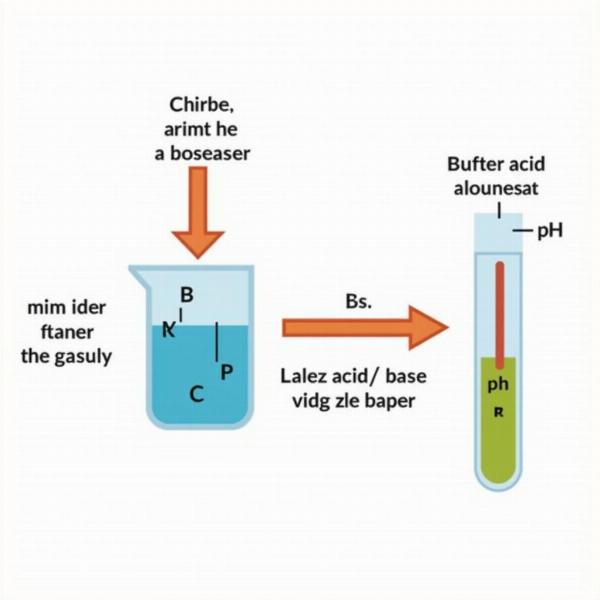Understanding the concept of a buffer system is crucial in various scientific fields, especially chemistry and biology. But what exactly does “buffer system” mean in Hindi, and why is it so important? This article will delve into the meaning, significance, and applications of buffer systems, providing a clear explanation in a way that resonates with Indian readers. We’ll explore the Hindi terminology, real-world examples, and practical implications of these fascinating chemical regulators.
What is a Buffer System?
A buffer system, referred to as “बफर प्रणाली” (buffer pranali) in Hindi, is a solution that resists changes in pH when small amounts of acid or base are added. Think of it as a chemical shock absorber, maintaining stability in the face of potentially disruptive additions. This stability is crucial for numerous biological and chemical processes that are sensitive to pH fluctuations. Whether it’s the delicate balance within our blood or the precise conditions required for a chemical reaction, buffer systems play a vital role.
 Buffer System Diagram
Buffer System Diagram
The Chemistry Behind Buffer Systems
How do these systems achieve such remarkable stability? The magic lies in their composition. A buffer system typically consists of a weak acid and its conjugate base, or a weak base and its conjugate acid. This pairing creates a dynamic equilibrium that can neutralize added acids or bases, effectively minimizing pH changes. For example, a common buffer system is the acetic acid/acetate buffer, where acetic acid (CH3COOH) is the weak acid and acetate (CH3COO-) is its conjugate base.
Understanding Weak Acids and Bases
The term “weak” in this context refers to the acid or base’s tendency to only partially dissociate in water. This partial dissociation is key to the buffer’s functionality. When an acid is added to the buffer, the conjugate base reacts with it, consuming the added H+ ions and preventing a significant drop in pH. Conversely, when a base is added, the weak acid reacts with it, releasing H+ ions to counteract the increase in pH.
Buffer Systems in Action: Real-World Examples
Buffer systems are ubiquitous in nature and have diverse applications. In the human body, the bicarbonate buffer system in blood maintains a pH of around 7.4, essential for proper functioning of enzymes and other biological molecules. In industrial settings, buffer systems are crucial in maintaining the pH of various products, from shampoos and cosmetics to pharmaceuticals and food.
Buffer System in Blood
The bicarbonate buffer system is a prime example of a buffer system in action. It involves carbonic acid (H2CO3) and its conjugate base, bicarbonate (HCO3-). This system effectively regulates blood pH, ensuring that it remains within a narrow range despite the continuous production of metabolic acids.
Why is Understanding Buffer Systems Important?
A grasp of buffer systems is fundamental for anyone studying chemistry, biology, or related fields. It provides insights into how biological systems maintain homeostasis and how chemical reactions can be controlled. Moreover, it helps in understanding the principles behind various industrial and technological applications.
Conclusion
Buffer systems, known as “बफर प्रणाली” in Hindi, are essential chemical regulators that maintain pH stability. Their importance spans from maintaining the delicate balance within our bodies to controlling industrial processes. This article has provided a comprehensive overview of buffer systems, their meaning, functionality, and real-world applications. Understanding these systems is crucial for anyone involved in the scientific field and provides valuable insights into the intricate workings of chemical and biological processes.
FAQ
- What is the Hindi word for buffer system? The Hindi word for buffer system is “बफर प्रणाली” (buffer pranali).
- What are the components of a buffer system? A buffer system typically consists of a weak acid and its conjugate base, or a weak base and its conjugate acid.
- Why are buffer systems important in the human body? Buffer systems, such as the bicarbonate buffer system in blood, are vital for maintaining a stable pH, which is essential for proper biological function.
- How do buffer systems work? Buffer systems work by neutralizing added acids or bases through the dynamic equilibrium between the weak acid/base and its conjugate.
- What are some examples of buffer systems in everyday life? Examples include the buffer systems in blood, shampoos, and certain food products.
- What is the difference between a strong acid and a weak acid in a buffer system? A weak acid only partially dissociates, which is crucial for its buffering capacity, while a strong acid fully dissociates.
- Where can I find more information about buffer systems? You can find more information in chemistry textbooks and online resources.
Related Articles:
- insufficient fund meaning in hindi
- clipboard meaning in hindi
- backbeaching meaning in hindi
- volatile memory meaning in hindi
Meaning-Hindi.in is your trusted partner for high-quality Hindi translation services. We specialize in various domains, including business, legal, technical, website localization, educational, and specialized translations. Whether you need quick translation services or expert assistance with technical documentation, our team of experienced translators is here to help. Contact us today for all your Hindi translation needs. Email: [email protected], Phone: +91 11-4502-7584. Meaning-Hindi.in provides accurate and culturally sensitive translations, ensuring your message is conveyed effectively.